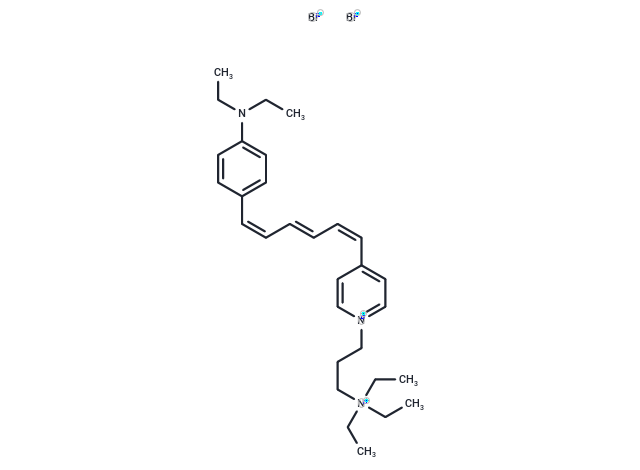Shopping Cart
Remove All Your shopping cart is currently empty
Your shopping cart is currently empty
FM4-64 (SynaptoRedTM C2) is a stylane-based dye that is largely non-fluorescent in aqueous solution. FM4-64 cannot passively diffuse into the cell interior after binding to the plasma membrane bilayer and must be transported across the membrane by active transport. FM4-64 can be used to study endocytosis exocytosis and vesicle trafficking.

| Pack Size | Price | USA Warehouse | Global Warehouse | Quantity |
|---|---|---|---|---|
| 1 mg | $337 | In Stock | In Stock | |
| 5 mg | $591 | In Stock | In Stock | |
| 10 mg | $857 | Inquiry | Inquiry | |
| 25 mg | $1,270 | Inquiry | Inquiry |
| Description | FM4-64 (SynaptoRedTM C2) is a stylane-based dye that is largely non-fluorescent in aqueous solution. FM4-64 cannot passively diffuse into the cell interior after binding to the plasma membrane bilayer and must be transported across the membrane by active transport. FM4-64 can be used to study endocytosis exocytosis and vesicle trafficking. |
| Cell Research | Instructions for use I. Solution preparation 1. Stock solution: Dissolve FM4-64 in DMSO or sterile water to prepare a high concentration stock solution (usually 1–5 mM). 2. Working solution: Dilute the stock solution to the working concentration (usually 1–10 µM) according to the experimental needs, using an appropriate buffer (such as PBS or serum-free medium). Notes: 1) FM4-64 is a membrane-affinity dye, but it cannot penetrate into cells, so it is suitable for labeling cell membranes or vesicle membranes. 2) The dye will degrade under light, so try to avoid light during operation. II. Operation steps 1. Cell experiment 1) Cell preparation: Culture cells to an appropriate density. Wash cells with serum-free medium or PBS before staining to remove residual substances. Staining steps: 2) Add the working solution directly to the cell culture medium and mix gently. 3) Incubate at an appropriate temperature (e.g., 37°C) for 5–30 minutes, which needs to be optimized based on the experiment. 4) Washing: Wash the cells multiple times with an appropriate buffer (e.g., PBS) to remove unbound dye. Optionally, use cold PBS to terminate staining and reduce background signal. 5) Imaging: Observe the sample using a fluorescence microscope. Excitation wavelength: ~515–540 nm. Emission wavelength: ~640–700 nm (red fluorescence signal). 2. Tissue experiments 1) Tissue preparation: Fix and permeabilize tissue sections (if necessary) to enhance dye penetration. 2) Staining steps: Add working solution to tissue sections and incubate for 10–30 minutes. 3) Washing: Wash tissue sections with PBS to remove excess dye. 4) Imaging: Also observe the red fluorescence signal using a fluorescence microscope. |
| Synonyms | SynaptoRedTM C2 |
| Molecular Weight | 607.51 |
| Formula | C30H45Br2N3 |
| Cas No. | 162112-35-8 |
| Smiles | [Br-].[Br-].CCN(CC)c1ccc(\C=C/C=C/C=C\c2cc[n+](CCC[N+](CC)(CC)CC)cc2)cc1 |
| Relative Density. | no data available |
| Storage | keep away from moisture,keep away from direct sunlight | Powder: -20°C for 3 years | In solvent: -80°C for 1 year | Shipping with blue ice/Shipping at ambient temperature. | |||||||||||||||||||||||||
| Solubility Information | DMSO: 30 mg/mL (49.38 mM), Sonication is recommended. | |||||||||||||||||||||||||
| In Vivo Formulation | 10% DMSO+40% PEG300+5% Tween-80+45% Saline: 1 mg/mL (1.65 mM), Sonication is recommeded. Please add the solvents sequentially, clarifying the solution as much as possible before adding the next one. Dissolve by heating and/or sonication if necessary. Working solution is recommended to be prepared and used immediately. The formulation provided above is for reference purposes only. In vivo formulations may vary and should be modified based on specific experimental conditions. | |||||||||||||||||||||||||
Solution Preparation Table | ||||||||||||||||||||||||||
DMSO
| ||||||||||||||||||||||||||
| Size | Quantity | Unit Price | Amount | Operation |
|---|

Copyright © 2015-2025 TargetMol Chemicals Inc. All Rights Reserved.